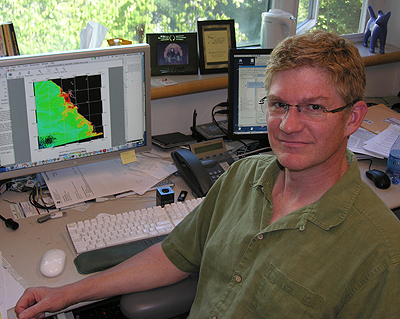After years of studying and monitoring harmful algal blooms in California's coastal waters, Raphael Kudela is trying to predict when toxin-producing algae will strike again. A professor of ocean sciences at UC Santa Cruz, Kudela leads a team of researchers that has received a $792,000 grant from the Ocean Protection Council and California Sea Grant to develop forecasts of the periodic blooms of toxic algae that have long plagued the California coast.
The researchers will focus initially on algae that produce the neurotoxin domoic acid, which causes amnesic shellfish poisoning in humans. During "blooms" of these algae (called Pseudo-nitzschia), when there are large numbers of them in the water, the toxin builds up in mussels, clams, and other shellfish, as well as in small fish such as anchovies and sardines. State monitoring programs and quarantines protect consumers from seafood tainted with domoic acid or other algal toxins. But seabirds and marine mammals are often affected and sometimes suffer massive die-offs during large blooms.
Kudela and other UCSC researchers have been working with the California Department of Public Health (CDPH) to develop new technologies for detecting and tracking harmful algal blooms in the coastal waters of California. As part of this effort, they have developed computer models that use data on a wide range of environmental variables to predict when conditions in Monterey Bay are likely to favor a bloom of Pseudo-nitzschia. Researchers in southern California have developed similar models for coastal waters off Santa Barbara.
"We are at the point now where we'd like to take these research projects and turn them into something that's useful for the state and the public," Kudela said. "We aim to develop a web-based tool to provide real-time updates for state agencies and wildlife managers. It will give them a heads-up so they know what to expect and how to prioritize their monitoring efforts."
Kudela's team plans to expand the scope of existing models to cover the entire coast of California. They also want to develop predictive models for another type of harmful algal bloom, which is responsible for paralytic shellfish poisoning. The team includes scientists at CDPH, UCLA, Jet Propulsion Laboratory, University of Southern California, Southern California Coastal Water Research Project (SCCWRP), and Central and Northern California Ocean Observing System (CeNCOOS).
The National Oceanic and Atmospheric Administration (NOAA) Ocean Service has provided much of the funding for previous work on harmful algal blooms by Kudela and his collaborators in southern California. SCCWRP and CeNCOOS are collaborative regional research and monitoring programs involving multiple agencies.
UCSC researchers have been monitoring for algal toxins at the Santa Cruz wharf for the past decade, and they know that their computer models are good at identifying the conditions in Monterey Bay that are associated with the presence of domoic acid. An unusual event this winter showed the potential for these models to provide valuable information, Kudela said. The annual quarantine on recreational shellfish harvesting had just been lifted when the model indicated a new episode of toxin production.
"Right after the annual closure was lifted, the model actually picked up an unusual event where the mussels got toxic again. We alerted the state and they closed harvesting again. So that's where we're headed, and ultimately we'll have a web site where you can go and get that kind of information," Kudela said.
This summer, perhaps due to El Niño conditions, both Monterey Bay and the Santa Barbara area have experienced an unusually prolonged bloom of Pseudo-nitzschia. "We've had a domoic acid event going on for almost two months now. Toxin levels got very high in Santa Barbara a few weeks ago, well over the regulatory limit, and it is affecting sea lions and possibly otters as well," Kudela said.
Worldwide, there has been a trend toward increasing frequency and severity of harmful algal blooms. In California, the patterns have certainly been changing over the past couple of decades, Kudela said.
"We've seen it waxing and waning, so it depends on the time frame you look at, but harmful algal blooms have become more common in central California over the last 10 years," he said. "We're also seeing shifts to southern California, where they've had domoic acid events nearly every year since 2000. Santa Barbara has become a real hot spot, and it never used to be. So the patterns are shifting, and we are seeing bigger blooms, blooms at unusual times of the year, and in places we haven't seen them before."
Information about NOAA Ocean Service harmful algal bloom programs supporting UCSC research is available online.



